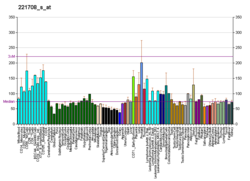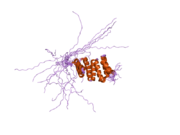| UNC45A |
|---|
 |
| Available structures |
|---|
| PDB | Ortholog search: PDBe RCSB |
|---|
|
|
| Identifiers |
|---|
| Aliases | UNC45A, GC-UNC45, GCUNC-45, GCUNC45, IRO039700, SMAP-1, SMAP1, UNC-45A, unc-45 myosin chaperone A, OOHE |
|---|
| External IDs | OMIM: 611219; MGI: 2142246; HomoloGene: 32423; GeneCards: UNC45A; OMA:UNC45A - orthologs |
|---|
| Gene location (Human) |
|---|
 | | Chr. | Chromosome 15 (human)[1] |
|---|
| | Band | 15q26.1 | Start | 90,930,180 bp[1] |
|---|
| End | 90,954,093 bp[1] |
|---|
|
| Gene location (Mouse) |
|---|
 | | Chr. | Chromosome 7 (mouse)[2] |
|---|
| | Band | 7|7 D2 | Start | 79,975,040 bp[2] |
|---|
| End | 79,997,741 bp[2] |
|---|
|
| RNA expression pattern |
|---|
| Bgee | | Human | Mouse (ortholog) |
|---|
| Top expressed in | - popliteal artery
- tibial arteries
- muscle layer of sigmoid colon
- Descending thoracic aorta
- ascending aorta
- right hemisphere of cerebellum
- body of uterus
- skin of leg
- gastric mucosa
- stromal cell of endometrium
|
| | Top expressed in | - external carotid artery
- mucous cell of stomach
- internal carotid artery
- olfactory epithelium
- lip
- Rostral migratory stream
- molar
- neural layer of retina
- tunica media of zone of aorta
- paraventricular nucleus of hypothalamus
|
| | More reference expression data |
|
|---|
| BioGPS |  | | More reference expression data |
|
|---|
|
| Gene ontology |
|---|
| Molecular function | - Hsp90 protein binding
- protein binding
- cadherin binding
| | Cellular component | - cytoplasm
- perinuclear region of cytoplasm
- nucleus
- Golgi apparatus
- cytosol
- nuclear speck
| | Biological process | - multicellular organism development
- cell differentiation
- muscle organ development
- chaperone-mediated protein folding
| | Sources:Amigo / QuickGO |
|
| Orthologs |
|---|
| Species | Human | Mouse |
|---|
| Entrez | | |
|---|
| Ensembl | | |
|---|
| UniProt | | |
|---|
| RefSeq (mRNA) | NM_001039675
NM_017979
NM_018671
NM_001323619
NM_001323620
|
|---|
NM_001323621 |
| |
|---|
| RefSeq (protein) | |
|---|
NP_001034764
NP_001310548
NP_001310549
NP_001310550
NP_061141 |
| |
|---|
| Location (UCSC) | Chr 15: 90.93 – 90.95 Mb | Chr 7: 79.98 – 80 Mb |
|---|
| PubMed search | [3] | [4] |
|---|
|
| Wikidata |
| View/Edit Human | View/Edit Mouse |
|

 2dba: The solution structure of the tetratrico peptide repeat of human Smooth muscle cell associated protein-1, isoform 2
2dba: The solution structure of the tetratrico peptide repeat of human Smooth muscle cell associated protein-1, isoform 2

















